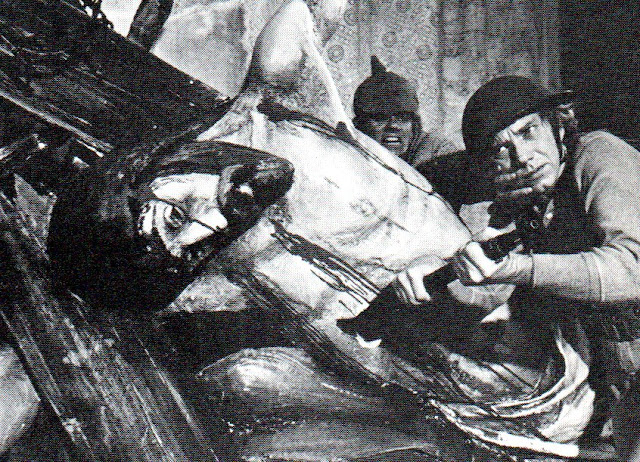 |
| Ralph Lydiard, Ralph Williams. |
JOHNNY JOHNSON
[Musical Revival] B/LY: Paul Green; M: Kurt Weill; D: Jose Quintero; CH:
Bertram Ross; S: Peter Harvey; C: Robert Fletcher; L: Roger Morgan; P: Timothy
Gray and Robert Fletcher i/a/w Midge La Guardia; T: Edison Theatre; 4/11/71 (1)
This third New York revival of Paul Green and Kurt Weill’s
satirical, antiwar musical of 1936 failed to survive for a second performance.
(See Ron
Fassler’s excellent reporting on the one-night flop phenomenon of the early 70s
here.) Its book, about a "good soldier Schweik"-like pacifist draftee in
World War I, long had been recognized as problematic; this version could not
find a means of shoring up its weak points. See below for my essay on the Group Theatre's original production, directed by Lee Strasberg.
Clive Barnes, for instance, believed that its message, “peace
at any price,” resulted in a naïve work that “seems like a terribly foolish
overture to World War II, which may have been the only morally inevitable war
in recorded history.”
Still, many were quite approving of Weill’s wonderful score,
the small orchestra used to play it, and the quality of the singing. The chief
reason cited for the show’s failure was the direction of Jose Quintero, despite
his distinguished director’s resume. A representative view pointed to the “inadequacy”
and lack of imagination on display. Quintero “only makes the plot deadlier,
creating no diversions or musicality without movement, and allowing no dance at
all,” according to Martin Gottfried.
The following is adapted from my essay on the original production, presented by the Group Theatre at the Forty-fourth Street Theatre, which opened on 11/19/36 and ran for 68 perormances. The essay is in my Encyclopedia of the New York Stage, 1930-1940.
Paul Green's play (called "a legend") was actually a musical, although, for some reason, not technically considered one in its time. It was supported by a brilliant score by a gifted fugitive from Nazi Germany, Kurt Weill, providing his first work for the American stage. Grenville Vernon said the music "is delightful and it is catchy, yet it has bite and savor." The Green-Weill collaboration bore echoes of Charlie Chaplin's film Shoulder Arms, the Czech play The Good Soldier Schweik, and the Georg Buchner play Woyzeck.
Many didn't know what to make of the episodic work because of its unusual form and combination of different styles, including realism, expressionism, musical comedy, cabaret, melodrama, fantasy, farce, polemic, and so forth. It elicited a number of carping comments, as a result. However, it impressed enough reviewers to have it voted second in the Drama Critics Circle competition, and to be counted as one of Burns Mantle's Ten Best of the Year.
The show--with 19 sets, it was the Group's most ambitious yet--had many pre-production difficulties. Group Theatre co-leader Harold Clurman was scheduled to direct but administrative duties forced him to turn the job over to Lee Strasberg. The company struggled, almost to opening night, to fund the nearly $60,000 production. Then there was designer Donald Oenslager's having lost all the sketches and ground plans at Woolworth's. Despite having seven shows opening on Broadway that month, and teaching two days a week, the busy designer was forced to replicate all his designs from memory in the little time he had available.
A major problem never overcome was the vastness of the Forty-Fourth Street Theatre--the only venue available--which swamped the intimate show and made many of its performances inaudible. When Clurman was later asked "Why did you take such a house?" he replied, "Take it? We had been shoved into it," as he reported in The Fervent Years.
The first previews proved disastrous because of the insufficient time for tech and dress rehearsals, and spectators left in droves. Panic-driven measures were taken, including the removal of musical numbers, as frayed nerves struggled to salvage the work. But, to everyone's surprise, the opening was smooth as ice, and the audience was enthusiastic. The reviews, though, were mostly a blend of critical faultfinding with admiration for the various effective contributions. Richard Lockridge called it "embarrassingly silly and cursed with that rather dreadful childishness which marks fantasy which is not coming off." Brooks Atkinson, on the other hand, tempered his mild negatives by stating, "Most of Johnny Johnson rings true because it has been written by a natural man who has a flavorsome speech and glorious imagination,"
The play, which evolved from discussions among Weill, Green, and Group producer Cheryl Crawford about what President Woodrow Wilson had called "the war to end all wars," concerns the efforts of idealistic American enlistee Johnny Johnson (Russell Collins), a tombstone cutter who believes in Wilson's words, to end all wars. This simple everyman, who sees the insanity of men slaughtering one another, captures a German sniper (Jules [John] Garfield); sends him back with peace bulletins; is wounded; steals a bottle of laughing gas from the hospital; and uses it on members of the Allied High Command, who go into hysterics and sign an end to the war. When the gas wears off, though, they renege.
Johnny is diagnosed as suffering from Peace Monomania and is locked up an asylum, where the psychiatrist (Morris Carnovsky) is nuttier than the patients, all of whom believe themselves to be members of the US Senate. At the end, after founding a League of World Republics with his fellow patients, Johnny is discharged and winds up peddling toys (but no tin soldiers) in the street.
The cast included Phoebe Brand, Robert Lewis, Elia Kazan, Lee J. Cobb, Curt Conway, Sanford Meisner, Roman Bohnen, Art Smith, Albert (Van) Dekker, Luther Adler, and Paul Mann, most of them eventually iconic theatre names.